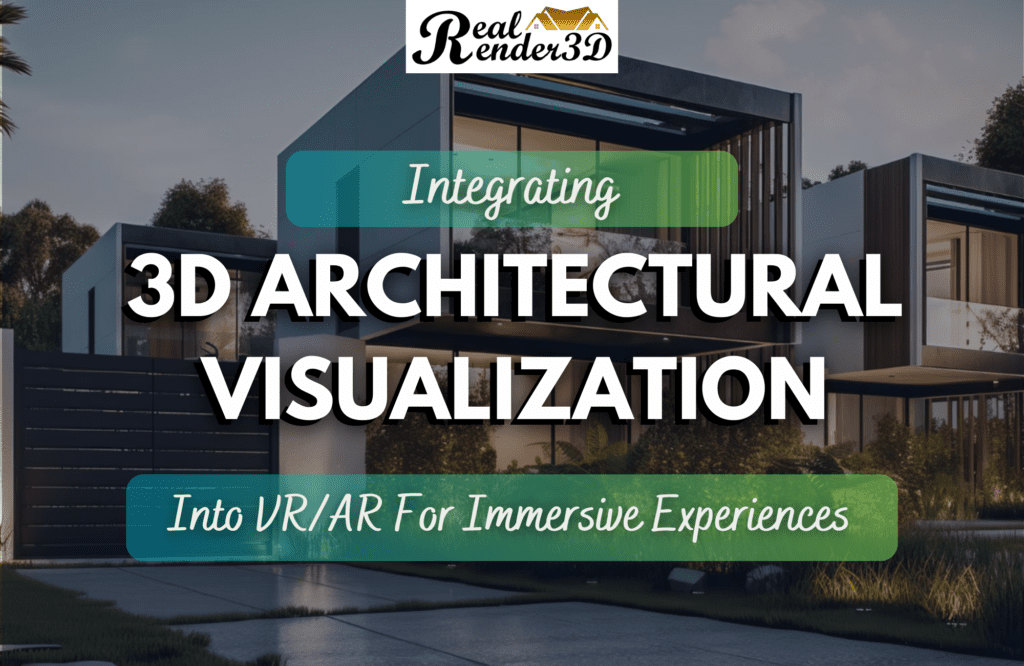Introdution
The world of architecture and design has seen a great change in recent years due to the transformative power of Virtual Reality (VR) and Augmented Reality (AR) Technologies. These immersive technologies have brought a great revolution in architectural visualization. They enable architects and designers, clients, and stakeholders to provide great opportunities to experience designs on a completely different dimension. Below, we discuss how VR and AR technologies transform the architectural visualization landscape, allowing for more interactive and insightful design processes.
Bringing Designs to Life With Virtual Reality
Virtual reality allows us to create amazing virtual tours, providing clients with a great sense of space and outstanding perspective on their future building. With VR technology, clients can navigate the virtual model by clicking on needed locations. Giving them the freedom to explore every corner of the design. VR headsets improve the experience by creating an illusion that the client is physically present within the space. This immersive technique helps clients comprehend spatial relationships, visualize adjacencies, and understand design concepts in real time.
Similarly, augmented reality provides clients with interactive and immersive experiences that enable them to learn 3D architectural design better. For more information, check out 3D Rendering & Architectural Visualization; How Much Should it Cost?
Empowering Customers Through Illuminating Experiences
One of the important merits of utilizing VR and AR technologies in 3D architectural visualization is the ability to assist clients through visualization challenges. Most individuals need help connecting architectural plans and 3D renderings with physical spaces. However, virtual reality closes this gap by allowing clients to immerse themselves in the design and gain a detailed understanding of the proposed structure. It also enables architects to easily explain their designs with the help of Virtual Home Stagging.
By exploring the virtual environment, clients can visualize how various elements interact with each other and experience the flow of spaces. This level of interaction empowers them to make informed decisions, provide valuable feedback, and identify potential changes. Moreover, VR enables clients to evaluate design choices comprehensively, from the impact of a specific carpet color to integrating architectural elements throughout the building.
Improved Collaboration & Communication
VR and AR solutions not only benefit customers but also provide enhanced collaboration and Communication among project stakeholders. These technologies are a significant sales tool for public clients like those involved in multi-shareholder endeavors. By sharing a link or QR code, stakeholders can access the 3D rendering on their mobile devices, providing them with an immersive experience and enabling them to visualize the future building accurately. The versatility of AR also improves Communication during the design process. With AR, clients can use printed documents or maps to imagine how the final design will look within its real-world surroundings. 3D rendering services greatly facilitate this.
Check out The Potential Of GCI in The Architecture Industry for further details. Through 3D modeling, clients can better understand the building’s placement and relationship with the environment, especially with the 3D models on the site. This method proves to be very helpful for exterior layouts, allowing clients to evaluate designs from various angles and even carry out cross-section analysis to get the internal arrangement, which is facilitated by 3D interior rendering.
Conclusion
Regarding the future of architectural visualization, augmented reality and virtual reality technologies have opened up new dimensions for both the clients and design teams. By utilizing these powerful tools, we can grow the traditional renderings and plans, providing customers with immersive, engaging experiences that facilitate an in-depth comprehension of architectural designs. The combination of VR and AR allows clients to visualize spaces, examine design choices, and participate actively in decision-making. This leads to improved project results and more client satisfaction.
Frequently Asked Questions
1. What are the major obstacles of virtual reality in architecture?
The major challenges of using VR and AR for design support are that it is very difficult to translate the changes made using the AR and VR systems into Building Information Modelling (BIM) models. Archiving AR and VR outputs for later review or to record the experience is also impossible.
2. How do VR and AR affect immersive learning?
AR and VR tools can lead to a better learning effect regarding targeted results. Immersive learning solutions minimize cognitive load, improve learner interaction, and strengthen memory. They can also allow immediate feedback during the process of learning.
3. How can virtual reality systems be used in architectural design?
Virtual reality enables architects to experience and comprehend buildings before their actual existence. Using VR reduces the time spent on meetings and presentations for customers.
4. What are the advantages of utilizing 3d in architectural visualizations and construction?
Using 3d models, professionals can utilize AR and VR to develop immersive experiences that allow clients and other project stakeholders to visualize projects in real-time. This helps in the design development process and makes Communication easier.
5. How is the use of virtual reality in architecture becoming more important?
By improving design visualization, involving clients in informed decision-making, growing collaboration among experts, and generating opportunities, VR is transforming the field of architecture.
6. How is virtual reality changing the architecture industry?
VR can create replicated environments in which architects, engineers, and designers can work together from all corners of the earth on the same 3d assets. This means that firms can work on projects regardless of the project members’ location, enhancing Communication and reducing travel expenditures.
7. Can augmented reality be utilized in architecture?
Augmented reality programs overlay images you see through digital devices like phones onto the physical world around you. Architects can, therefore, use this technology to plan projects and evaluate how they look in the real world.
Alex Smith is a content writer at RealRender3D, writing informative articles on 3D rendering, interior design, architecture, and related topics.
With over 15 years of experience at top UK architecture and interior design firms, Alex leverages his expertise to write engaging content educating readers on AEC industry trends and best practices.
Connect with Alex at alex@realrender3d.co.uk.
